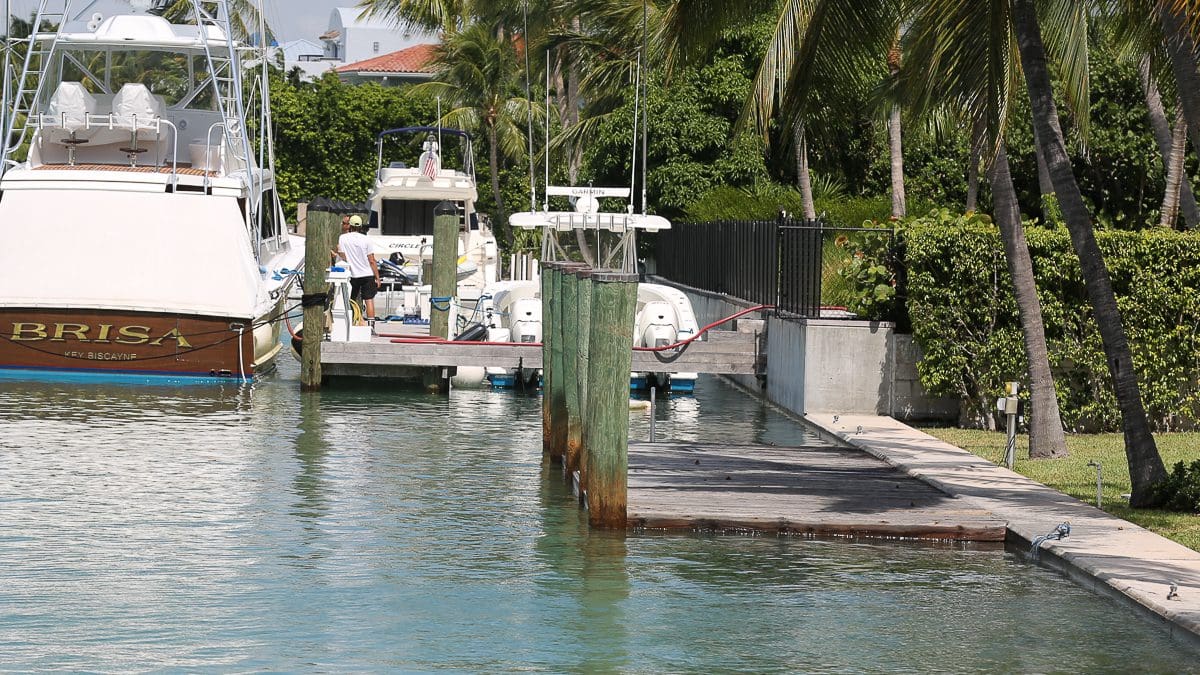Squaring off against the Village manager and staff – and questioning nationally-accepted projections of sea level rise – three members of Key Biscayne’s Village Council denounced a proposed ordinance to mandate taller and stronger seawalls.
The proposal has roiled owners of Key Biscayne’s priciest homes, as it could double the height of many existing seawalls. It would mandate a uniform height of 6.5 feet for properties on Biscayne Bay that owners would be required to have in place by 2035 — or earlier if there were renovation to a home or repairs to an existing seawall.
The height, based on federal government sea level rise projections, is in line with other local municipalities and Miami-Dade County, officials said. The Village currently does not have any seawall height requirement.
Most seawalls on the island range from two to four feet, according to an October analysis by the Village’s consulting firm, Moffat and Nichol.
Carlos de la Cruz, a wealthy business owner, art collector, and philanthropist, is among those in opposition, hosting a meeting with Village staff at his bayside home. He said with estimates continually changing, the whole topic should be tabled.

And that was the same theme being sounded by Council Members Brett Moss, Ed London and Fernando Vazquez, all criticizing the legislation at the June 6 Council meeting as premature and based on science they sought to downplay.
Invest in Local News for Your Town. Your Gift is tax-deductible
“We’re dealing with an issue of high uncertainty here – very, very high uncertainty with the projections of sea level rise, the politics behind sea level rise, the economics behind sea level rise,” said Vazquez.
In an interview Sunday, Vazquez stood by his comment, saying “there is a substantial debate on the science itself,” but he emphasized that while seawall standards are premature, he believes the Village will find a workable solution.
Moss said sea level rise is happening “very gradually” and therefore it would be just fine to wait until properties actually start flooding — and if that happens, give owners a year to correct the problem. He did not return calls and messages seeking to clarify his comment.
Even blunter was London, who chided the Village manager for even broaching the subject.
“Why are we going ahead and getting everybody concerned?” London said.
Rumya Sundaram, the Key Biscayne Independent science editor, said the comments from Council members were disappointing. “It’s unfortunate that they’re saying it’s unclear, because the science is quite settled in the matter.”
Ironically, Vazquez, a flood control engineer, had persuaded the Village to unanimously adopt a specific federal sea level rise estimate known as the “NOAA Intermediate High” forecast when he was an executive with AECOM, another Village consulting firm.
Since then, observations of sea level rise in the Southeastern U.S. are exceeding the NOAA models, according to an April article in Scientific American.
What happens next is unclear. Williamson, who plans to get additional comments from the community at a Key Biscayne Yacht Club Tuesday, seemed to acknowledge he didn’t yet have the votes.
“If it’s the Council’s will, we’ll just do more of a recommendation approach as opposed to a requirement approach,” he said.
But abandoning a requirement would be a mistake, said Jennifer Stearns Buttrick, an attorney who recently updated a seawall. “I think we need to be proactive. I don’t think kicking it down the road is an appropriate way to handle it.”
There are 278 property owners, mostly on the bay side, that could be affected by such an ordinance. Market values for bayside homes at the end of Mashta Island, for example, range anywhere from $9.5 million to $41.6 million, according to Zillow.com.
Roland Samimy, chief resilience and sustainability officer for the Village, said regulations need to be a priority because the seawalls tie into much larger outfall pipes. The bigger pipes are part of a massive replumbing of the island’s antiquated drainage lines.
The seawall legislation wasn’t the only subject of Moss’s criticism of Williamson and his administration. Later the same night, he launched a broadside on the main components of the Villages’s $250 million package of resiliency projects, voicing doubts about the “dig once” strategy and a 15-year timeline were still appropriate.
A $1.4 million work order to advance the infrastructure project –already behind schedule according to Williamson — remains on hold. The Council opted instead to hold a workshop, but no date has been set for it.
Seawalls are definitely a lightning rod. In 2021, Miami-Dade rejected a $4.5 billion Army Corps of Engineers plan to build flood walls and gates around Biscayne Bay to protect neighborhoods from storm surge. Critics worried it would harm seagrass and marine life in the bay.
De la Cruz, the art collector, suggested the Village wait for the results of a comprehensive Back Bay study from the Corps expected in the coming years.
“Maybe, the next generation of houses has to be built on stilts,” he said. “Maybe the idea on the peninsulas is just to let the water run over it.”




